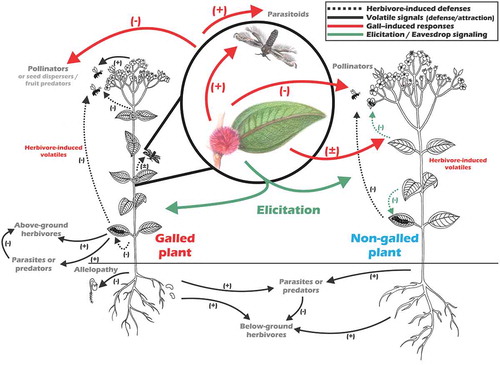Figures & data
Figure 1. Hypothetical framework of plant–plant interactions by volatile organic compoundsCitation8 which, due to different gall life stages, could temporally permit events ranging from pollinator attraction to allopathy in order to avoid competition (black arrows). The plant volatiles are induced as defensive mechanisms in response to herbivores and consequently affect herbivore activity (dashed black arrows), directly by repelling them or indirectly by attracting herbivore enemies (e.g. parasitoids). However, assuming that herbivory induced responses on plants (wider and red arrows) are temporally extended when compared with other herbivores. According to this, in addition to the direct and indirect effects this temporal extention of responses may include effect both above and below-ground organisms and interactions related to the infested plants and their neighboring community. These gall-induced responses may affect neighboring plants by eliciting or allowing eavesdropping on olfactory cues (green arrows). Among them, elicitation from gall metabolism may enable plants, including the non-galled ones, to exhibit specific herbivore-induced responses. Particularly, it allows to hypothesize that gall cues signals to neighboring plants can be either positive – reducing the attractiveness of gallers or attracting natural enemies of galls – or negative – by indicating to the galling insects possible host plants. These signals may be used for both, pollinators, seed dispersers and parasitoids also to avoid or fing resources on plants infested by galling insects directing them to specific niches. For instance, volatile cues from induced defense may induce parasitoids to plants with galling insects presence, and other herbivores or pollinators may use thes cues to avoid galled plants with possibly lower resources available.

